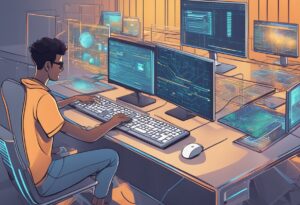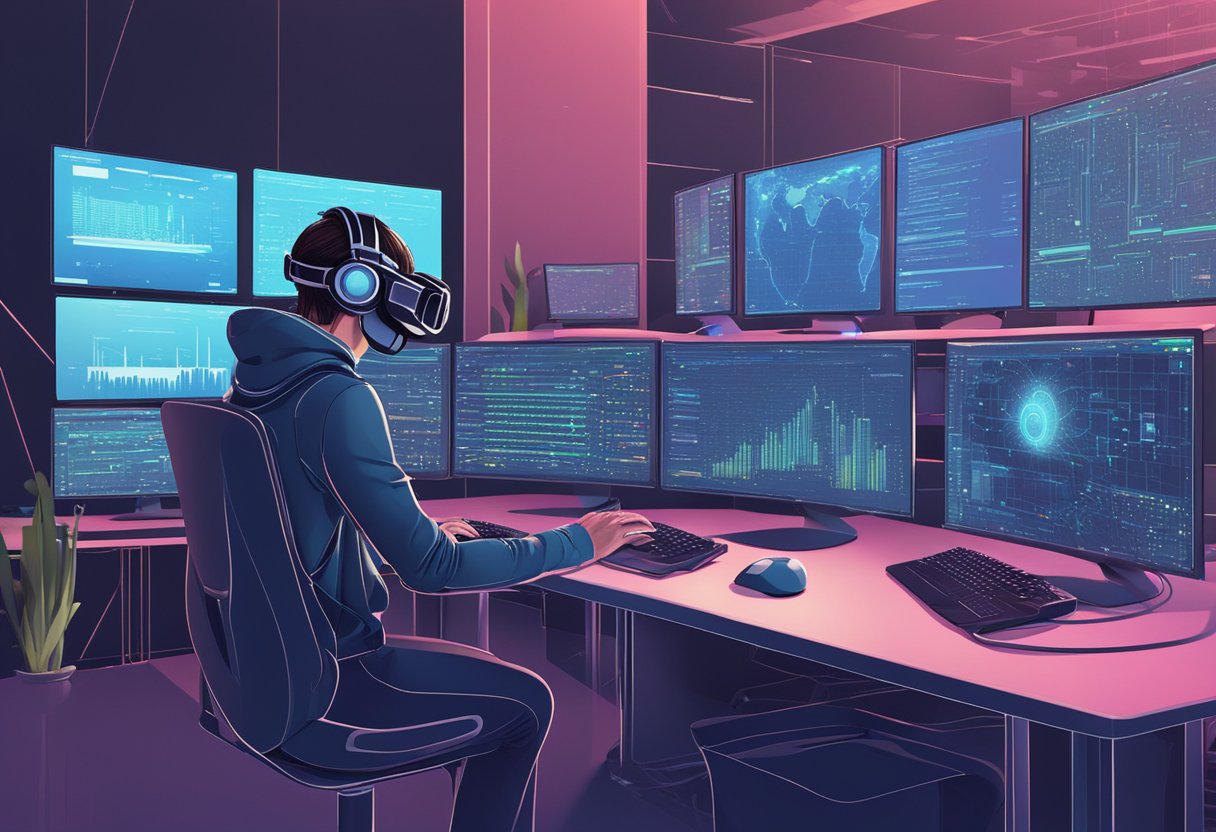Coding for metaverse is a rapidly growing field that involves programming for virtual worlds. The metaverse is a collective virtual shared space that enables people to interact with each other in a virtual environment. It is essentially a 3D internet that allows people to create, share, and interact with content in a virtual world.
Developers who are interested in coding for the metaverse need to have a solid understanding of programming languages such as C++, Java, Python, and JavaScript. These languages are essential for creating interactive experiences and 3D models within the metaverse. Developers should be familiar with game engines such as Unity and Unreal Engine, which are commonly used to create virtual worlds.
In order to be successful in the field of coding for metaverse, developers must also possess skills in 3D modeling and animation, multiplayer networking, UI/UX design, and cybersecurity. With the rise of virtual reality and augmented reality, the demand for skilled developers in this field is expected to grow rapidly. As such, developers who are interested in coding for metaverse have a unique opportunity to be at the forefront of a rapidly evolving industry.
Fundamentals of Metaverse Development
Understanding the Metaverse
Metaverse development is the process of creating virtual worlds that users can interact with. The Metaverse is a collective virtual shared space that is created by the convergence of virtual reality, augmented reality, and the internet. The Metaverse is a fully immersive, interactive, and social environment that allows users to engage with each other and with digital objects in real-time.
To develop for the Metaverse, developers need to have a good understanding of the Metaverse ecosystem. This includes knowledge of virtual reality, augmented reality, programming languages, and development platforms like Unity, Unreal, and Decentraland.
Programming Languages for the Metaverse
Metaverse development requires knowledge of programming languages like C++, Java, JavaScript, Python, Rust, C#, Lua, and Solidity. Each language has its strengths and weaknesses, and developers need to choose the right language that suits their project requirements.
C++ is a popular language for creating high-performance, real-time applications. Java is a general-purpose language that is used for creating cross-platform applications. JavaScript is a scripting language that is used for creating web applications. Python is a high-level language that is easy to learn and is used for creating machine learning models. Rust is a systems programming language that is designed to be safe and fast.
C# is a language that is used for creating games and applications on the Unity platform. Lua is a lightweight scripting language that is used for creating games and applications. Solidity is a language that is used for creating smart contracts on the Ethereum blockchain.
To develop for the Metaverse, developers need to have a good understanding of the Metaverse ecosystem and choose the right programming language that suits their project requirements.
How to Code for Metaverse Platforms
To become a proficient programmer for Metaverse platforms, one must possess a set of skills and knowledge of specific programming languages and technologies. Here are the steps needed to become a programmer for Metaverse platforms:
- Learn the basics of programming: Before diving into Metaverse programming, one must have a solid foundation in programming concepts such as data structures, algorithms, and object-oriented programming.
- Choose a Metaverse platform: There are several Metaverse platforms to choose from, including Decentraland, VRChat, and Somnium Space. Each platform has its own set of tools and programming languages, so it’s important to choose one that aligns with your interests and skillset.
- Learn the programming languages: Different Metaverse platforms use different programming languages. For example, Decentraland uses Solidity, a programming language used for Ethereum blockchain development, while VRChat uses C# and Unity. It’s important to learn the programming languages specific to the platform you choose.
- Develop 3D modeling and animation skills: Metaverse platforms rely heavily on 3D modeling and animation to create immersive experiences. Learning how to create 3D models and animations is essential for Metaverse programming.
- Develop multiplayer networking skills: Metaverse platforms are designed for social interaction, so learning how to create multiplayer experiences is crucial. This includes learning how to create multiplayer games, chat systems, and social networks.
- Develop UI/UX design skills: Creating a user-friendly interface and experience is critical for Metaverse platforms. Learning how to design user interfaces and user experiences is essential for Metaverse programming.
- Learn cybersecurity: As with any online platform, Metaverse platforms are vulnerable to cyber attacks. Learning how to secure Metaverse platforms is essential for creating a safe and secure environment for users.
By following these steps, one can become a proficient programmer for Metaverse platforms.

Building Blocks of Metaverse Platforms
The metaverse is built on a variety of technologies and platforms that work together to create immersive digital environments. In this section, we will explore some of the key building blocks of metaverse platforms.
Game Engines and Development Tools
Game engines and development tools are an essential part of creating metaverse platforms. The two most popular game engines used for metaverse development are Unreal Engine and Unity. These engines provide developers with the tools they need to create immersive 3D environments, as well as the ability to add physics, sound, and other interactive elements.
Open source development tools are also an important part of the metaverse ecosystem. These tools allow developers to create custom solutions and collaborate on projects with other developers. Some popular open source tools for metaverse development include Godot, Blender, and GIMP.
Blockchain and Cryptocurrency in the Metaverse
Blockchain technology and cryptocurrency are also key building blocks of metaverse platforms. Blockchain technology provides a secure and decentralized way to manage digital assets, while cryptocurrency allows for easy and secure transactions within the metaverse.
Non-fungible tokens (NFTs) are a type of digital asset that can be used to represent unique items within the metaverse, such as virtual real estate or rare in-game items. These tokens are stored on a blockchain, providing a secure and transparent way to verify ownership.
The use of blockchain technology and cryptocurrency in the metaverse is expected to grow in the coming years as more developers and users adopt these technologies.
Creating Immersive and Interactive Experiences
The Metaverse offers endless possibilities for creating immersive and interactive experiences. In order to create such experiences, developers must have a deep understanding of 3D graphics, virtual world design, avatars, social interactivity, and community building.
3D Graphics and Virtual World Design
The use of 3D graphics is essential in creating immersive experiences in the Metaverse. It allows developers to create realistic environments that users can explore and interact with.
Virtual world design is also important in creating immersive experiences. Developers must consider factors such as lighting, textures, and sound to create a believable and engaging environment for users.
Avatars and Social Interactivity
Avatars are the digital representations of users in the Metaverse. They allow users to interact with each other and the virtual environment. Developers must create avatars that are customizable and expressive, allowing users to personalize their experience in the Metaverse.
Social interactivity is also important in creating immersive experiences. Developers must create social features that allow users to connect and interact with each other in meaningful ways.
Creating immersive and interactive experiences in the Metaverse requires a deep understanding of 3D graphics, virtual world design, avatars, social interactivity, and community building. By leveraging these elements, developers can create engaging and memorable experiences that keep users coming back for more.
Security, Performance, and Optimization
Maintaining Security in the Metaverse
Security is a crucial aspect of the Metaverse, especially considering the vast amounts of sensitive information and data that are exchanged within virtual spaces. Developers must ensure that the Metaverse is secure by implementing robust security measures such as encryption, authentication, and authorization protocols.
To maintain security in the Metaverse, developers must also conduct regular vulnerability assessments and penetration testing to identify and address any potential security threats. They must keep up-to-date with the latest security trends and technologies to ensure that the Metaverse remains secure in the face of evolving security threats.
Performance Tuning for Virtual Spaces
Performance tuning is another critical aspect of the Metaverse, as it can significantly impact the user experience. Developers must optimize virtual spaces to ensure that they perform optimally, even when handling large amounts of data and complex real-time interactions.
To achieve optimal performance, developers must optimize network connectivity, reduce latency, and minimize resource consumption. This can be achieved by implementing efficient data structures and algorithms, using appropriate caching strategies, and leveraging distributed data processing techniques.
Ensuring security and optimizing performance are critical aspects of developing the Metaverse. By implementing robust security measures and optimizing virtual spaces, developers can create a secure and high-performance Metaverse that provides users with an immersive and engaging experience.
The Ecosystem of Metaverse Development
The development of metaverse applications is a complex process that requires a diverse range of skills and tools. This section explores the various components of the metaverse development ecosystem and how they work together to create immersive experiences.
Communities and Collaboration
Communities play a crucial role in the development of metaverse applications. Developers can leverage online communities to collaborate, share knowledge, and build new applications. These communities also provide a platform for users to interact, share ideas, and provide feedback on new features and applications.
Open standards and interoperability are key components of metaverse development. Developers can use open standards to create applications that can work across multiple platforms, ensuring maximum accessibility for users. Interoperability allows for seamless integration between different applications, creating a more immersive and interconnected metaverse experience.
Publishing and Monetization Strategies
Publishing and monetization strategies are essential components of metaverse development. Developers need to consider how they will distribute their applications and how they will monetize them. Web3 games are a popular way to monetize metaverse applications, allowing developers to create games that use blockchain technology to provide unique and valuable in-game assets.
Machine learning is another important component of metaverse development. Developers can use machine learning to create intelligent applications that can learn and adapt to user behavior. This can help create more immersive and personalized experiences for users.
Software development is the backbone of metaverse development. Developers need to have a solid understanding of software development principles and best practices to create high-quality applications.
They also need to be able to work with a wide range of programming languages and tools to create applications that can run across multiple platforms.
The metaverse development ecosystem is a complex and multifaceted environment that requires a diverse range of skills and tools. Developers need to be able to collaborate effectively, use open standards and interoperability, and have a solid understanding of software development principles to create high-quality metaverse applications.

Frequently Asked Questions
What are the first steps to begin development in the metaverse?
To begin development in the metaverse, one should have a basic understanding of programming languages and technologies. It is essential to learn 3D modeling and animation, XR development, smart contracts, and cybersecurity. One can start by learning programming languages like Python, JavaScript, Swift, C#, and C++. One can learn about multiplayer networking, UI/UX design, and cybersecurity. It is also recommended to join online communities and forums to learn from experienced developers.
Which programming languages are most effective for creating augmented reality applications?
Programming languages like C++, C#, Swift, and Java are commonly used for developing augmented reality applications. These languages provide the necessary tools and libraries to create complex AR applications. JavaScript can also be used for developing AR applications, especially for web-based AR experiences.
Is JavaScript suitable for metaverse development projects?
JavaScript is a popular programming language used for web development, and it can be used for metaverse development projects. It is commonly used for creating web-based AR experiences and can also be used for developing VR experiences. However, it is recommended to learn other programming languages like C++, C#, and Python for more complex metaverse development projects.
How does Rust fit into the metaverse programming landscape?
Rust is a relatively new programming language that is gaining popularity in the metaverse programming landscape. It is known for its safety and performance and is commonly used for developing decentralized applications and smart contracts. Rust can also be used for developing VR and AR experiences, and it is recommended for developers who want to create high-performance applications.
What coding language is commonly used for developing Google AR apps?
Google AR apps are developed using the ARCore SDK, which provides support for programming languages like Java, C++, and Unity. Java is commonly used for developing Android applications, and it can also be used for developing AR applications. C++ is known for its performance and can be used for creating complex AR applications. Unity is a game engine that provides support for AR development and is commonly used for creating AR experiences.
What is the preferred programming language for developing on Meta Quest?
Meta Quest is a VR headset developed by Oculus, and it provides support for developing VR experiences using the Unity game engine. Unity provides support for programming languages like C#, and it is the preferred programming language for developing on Meta Quest. C# is a popular programming language used for developing games and provides support for creating complex VR experiences.




